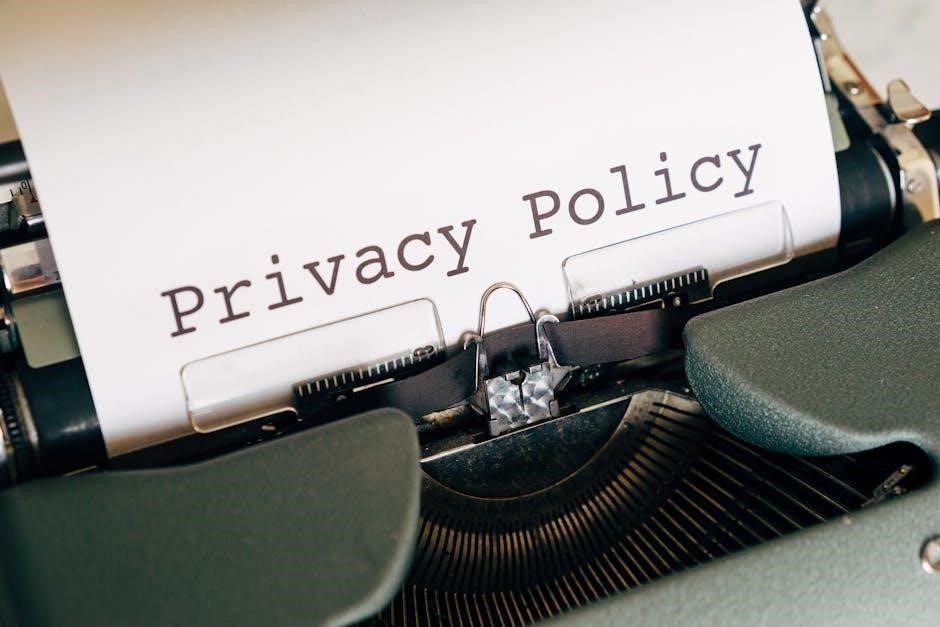
the policy manual is typically updated:
A policy manual is a comprehensive guide outlining an organization’s principles, rules, and procedures․ It is typically updated regularly to ensure relevance and compliance with evolving requirements․
1;1 Definition and Purpose
A policy manual is a dynamic and essential document that outlines an organization’s official rules, guidelines, and procedures․ Its primary purpose is to provide clear direction, ensure compliance, and promote consistency in decision-making․ It serves as a reference for employees, stakeholders, and leadership, fostering a culture of accountability and transparency․ Regular updates ensure the manual remains relevant, addressing legal, operational, and strategic changes while aligning with organizational goals and industry standards․
1․2 Importance in Organizational Governance
A policy manual is crucial for organizational governance as it provides clear guidelines that ensure consistency and compliance across all levels․ It serves as a central reference for employees, leadership, and stakeholders, promoting accountability and transparency․ Regular updates align the manual with evolving strategic objectives and legal requirements, ensuring relevance and effectiveness․ This maintains organizational integrity, fosters trust, and supports informed decision-making, ultimately driving sustainable success․

Reasons for Updating Policy Manuals
Policy manuals are typically updated to reflect changes in laws, organizational restructuring, stakeholder feedback, and emerging industry best practices, ensuring alignment with strategic objectives․
2․1 Changes in Laws and Regulations
Policy manuals are typically updated to comply with new or amended laws and regulations․ Legal changes often require revisions to ensure alignment with current standards, avoiding non-compliance risks․ Organizations must proactively monitor legislative updates and adapt their policies accordingly․ This ensures that all guidelines remain lawful and relevant, protecting the organization from potential legal issues; Regular reviews of laws and regulations are essential to maintain compliance and provide clear, updated guidance to employees and stakeholders․
2․2 Organizational Structural Changes
Policy manuals are often updated in response to organizational structural changes, such as the creation of new departments, shifts in leadership, or mergers and acquisitions․ These changes frequently require new or revised policies to reflect updated roles, responsibilities, and operational processes․ For instance, restructuring may introduce new compliance requirements or alter existing workflows, necessitating updates to ensure alignment with the organization’s new direction․ Regular reviews of the manual during such transitions help maintain clarity and consistency, supporting smooth operations and employee understanding․
2․3 Feedback from Employees or Stakeholders
Policy manuals are often updated based on feedback from employees or stakeholders, ensuring the document remains practical and aligned with organizational needs․ This feedback may highlight outdated procedures, unclear policies, or gaps in guidance․ By incorporating suggestions, organizations can improve clarity, address specific concerns, and foster a more inclusive work environment․ Regularly soliciting input through surveys or committees helps maintain relevance and ensures the manual evolves to meet the changing needs of both employees and the organization as a whole․
2․4 Emerging Industry Best Practices
Policy manuals are typically updated to align with emerging industry best practices, ensuring the organization remains competitive and efficient․ As industries evolve, new standards and methodologies arise, requiring adjustments to existing policies․ These updates often focus on improving operational efficiency, enhancing compliance, and incorporating innovative approaches․ By adopting best practices, organizations can address emerging challenges, leverage new technologies, and maintain a proactive stance in their field․ Regular updates ensure the manual reflects current trends and supports long-term organizational success and adaptability in a changing landscape․

The Process of Updating Policy Manuals
The process involves reviewing existing policies, incorporating feedback, and aligning with new regulations or standards․ Updates are finalized after approval and communicated to relevant stakeholders․

3․1 Steps Involved in the Update Process
The update process begins with initiating the review of existing policies․ This involves identifying outdated or irrelevant content․ Next, stakeholders provide feedback, ensuring alignment with organizational goals․ Legal and compliance teams verify adherence to current regulations․ Revised policies are then drafted, approved by authorized personnel, and documented for version control․ Finally, updates are communicated to employees through training or notifications, ensuring understanding and implementation․ This structured approach ensures the manual remains accurate, relevant, and effective in guiding organizational operations․
3․2 Roles and Responsibilities
Updating a policy manual involves collaboration across multiple roles․ The policy team typically leads the process, ensuring updates align with organizational goals․ Legal and compliance experts review for regulatory adherence․ Department heads provide input on operational feasibility․ HR often assists in communicating changes to employees․ IT may handle documentation and version control․ Employees are expected to familiarize themselves with updates․ Clear roles ensure accountability and a smooth transition to new policies, maintaining consistency and compliance across the organization․
3․3 Tools and Resources Used
Updating policy manuals often involves specialized tools and resources․ Software like Microsoft Word or Google Docs is used for drafting and editing․ Version control tools, such as Git or SharePoint, help track changes․ Collaboration platforms like Slack or Trello facilitate team input․ Legal databases ensure compliance with current regulations․ Additionally, templates and style guides maintain consistency․ Training materials and communication tools, like email or intranet, help disseminate updates․ These resources streamline the process, ensuring accuracy and efficiency in maintaining the policy manual․
3․4 Documentation and Approval Procedures
Documentation and approval are critical steps in updating policy manuals․ All changes are thoroughly documented, with version control to track revisions․ Approvals involve stakeholders like legal teams and senior management to ensure compliance and accuracy․ Once finalized, updated manuals are archived securely, and employees are notified․ Proper documentation ensures transparency, while structured approval processes maintain authority and accountability․ This systematic approach guarantees that updates are validated and communicated effectively across the organization․

Frequency of Policy Manual Updates

Policy manuals are typically updated annually or quarterly, depending on organizational needs․ Updates may also occur in response to legal changes or stakeholder feedback․
4․1 Scheduled Updates (e․g․, Annual, Quarterly)
Scheduled updates ensure policy manuals remain current and aligned with organizational goals․ Annual updates are common, allowing time for comprehensive reviews․ Quarterly checks may occur in dynamic industries․ This approach ensures consistency and compliance with evolving laws․ Regular updates prevent outdated policies from causing issues․ Organizations often align updates with strategic planning cycles․ Scheduled updates promote proactive governance and accountability․ They also help integrate feedback and industry trends systematically․ This method ensures policies evolve alongside organizational needs and external requirements, maintaining relevance and effectiveness over time․
4․2 Event-Driven Updates
Event-driven updates occur in response to specific events, such as legal changes, organizational restructuring, or significant incidents․ These updates ensure policies adapt to new circumstances․ For example, a change in legislation may require immediate revisions to comply with new regulations․ Similarly, a major incident within the organization might prompt updates to prevent future occurrences․ Event-driven updates are reactive but crucial for maintaining relevance and addressing unforeseen challenges․ They ensure policies remain effective and aligned with current realities, providing guidance during unexpected situations․ This approach keeps the manual responsive and practical in a changing environment․
4․3 Ad-Hoc Updates Based on Feedback
Ad-hoc updates occur when feedback from employees, stakeholders, or audits reveals the need for policy revisions․ These updates are unscheduled and address specific concerns or clarifications․ Feedback might highlight outdated procedures, ambiguous language, or gaps in guidance․ By incorporating this input, organizations ensure policies remain practical and aligned with employee needs․ Ad-hoc updates demonstrate a proactive approach to improving the manual’s effectiveness and fostering a culture of continuous improvement․ This method ensures the manual stays relevant and responsive to evolving workplace dynamics and feedback․

Key Sections Typically Updated
5․2 Policies and Procedures
Policies and procedures within a policy manual are typically updated to reflect changes in laws, organizational structure, or industry best practices․ These updates ensure compliance and alignment with current standards․ Revisions may include new guidelines, updated protocols, or clarifications on existing rules․ Feedback from employees or stakeholders often drives these changes, ensuring the manual remains relevant and practical․ Updates to policies and procedures are essential for maintaining operational consistency and addressing emerging challenges․ They also help in streamlining processes and improving overall efficiency within the organization․
5․3 Compliance and Legal Requirements
The policy manual is typically updated to ensure compliance with changing laws and legal requirements․ This involves incorporating new regulations, amending existing policies, and removing outdated clauses․ Legal updates are often driven by amendments to labor laws, data protection acts, or industry-specific regulations․ Ensuring the manual aligns with current legal standards helps the organization avoid penalties and maintains credibility․ Regular reviews by legal experts or compliance officers are essential to identify necessary updates and implement them effectively, safeguarding the organization’s operations and reputation․
5․4 Employee Conduct and Expectations
The policy manual is typically updated to reflect changes in workplace expectations and standards․ This includes revisions to codes of conduct, ethical guidelines, and behavioral expectations to align with evolving organizational values․ Updates may address new laws affecting employee rights, workplace safety protocols, or diversity and inclusion practices․ Additionally, feedback from employees or changes in industry norms often prompt updates to ensure policies remain relevant and fair․ These updates help maintain a positive work environment and clarify expectations, fostering accountability and professionalism among staff․

Best Practices for Updating Policy Manuals
Best practices include involving stakeholders, ensuring clarity, training employees, and maintaining version control․ Regular updates and clear communication ensure policies remain effective and aligned with organizational goals․
6․1 Ensuring Clarity and Accessibility
Clarity and accessibility are crucial for effective policy manuals․ Use plain language to avoid ambiguity, ensuring all employees understand the content․ Organize policies logically, with clear headings and sections․ Utilize search functions or indexes to help users quickly locate specific information․ Ensure the manual is accessible to all staff, including those with disabilities, by providing alternative formats if needed․ Regularly review and simplify complex sections to enhance comprehension․ These practices ensure the manual remains a valuable, user-friendly resource for the entire organization, promoting adherence to policies and procedures․
6․2 Involving Relevant Stakeholders
Involving relevant stakeholders ensures diverse perspectives are considered during policy updates․ Collaborate with employees, managers, and legal experts to gather feedback and insights․ This fosters ownership and alignment with organizational goals․ Use surveys, focus groups, or committees to collect input, ensuring the manual reflects real-world needs․ Stakeholder involvement also helps identify gaps and enhances compliance․ Regular communication keeps everyone informed, fostering trust and cooperation․ By engaging stakeholders, the policy manual becomes a practical, widely accepted resource that supports organizational objectives and adapts to changing requirements effectively․
6․3 Training Employees on Updates
Training employees on policy updates ensures understanding and compliance․ Organizations should provide clear, accessible training through workshops, webinars, or written materials․ Regular updates help employees stay informed about changes, reducing misunderstandings․ Engaging training methods, like interactive sessions or quizzes, enhance retention․ Feedback mechanisms allow employees to ask questions and clarify doubts․ This fosters a culture of compliance, alignment with organizational goals, and trust among employees․ Consistent training reinforces the importance of adhering to updated policies, ensuring smooth implementation and minimizing risks․
6․4 Version Control and Documentation
Version control and documentation are critical for tracking policy manual updates․ Numbered versions and change logs ensure clarity on modifications․ Documenting updates provides transparency, accountability, and a clear audit trail․ This process helps organizations maintain consistency and avoid errors․ Detailed records of updates, including dates and authors, ensure accountability․ Regular documentation also aids in training and communication, keeping stakeholders informed․ Proper version control supports organizational goals by ensuring everyone references the latest policies, fostering credibility and trust in the manual’s accuracy and reliability․

Importance of Regular Updates
Regular updates ensure compliance, align policies with organizational goals, provide clear guidance, and maintain credibility and trust in the manual’s accuracy and relevance to current operations․

7․1 Staying Compliant with Laws
Regular updates ensure the policy manual aligns with changing laws and regulations, reducing legal risks and penalties․ Compliance is maintained by incorporating new requirements promptly, ensuring all policies reflect current legal standards․ This systematic approach helps organizations avoid non-compliance issues, protecting their operations and reputation․ By staying updated, organizations demonstrate commitment to legal adherence, fostering trust and reliability in their governance practices․ Regular reviews and updates are essential to mitigate risks associated with outdated policies and ensure continuous alignment with evolving legal frameworks․
7․2 Aligning with Organizational Goals
Regular updates ensure the policy manual aligns with the organization’s evolving strategic direction․ As goals and objectives change, the manual adapts to reflect new priorities, ensuring consistency across operations․ This alignment helps maintain organizational focus and drives performance․ Updates also incorporate feedback, fostering a culture of continuous improvement․ By keeping policies relevant to the organization’s mission, the manual supports long-term success and adaptability in a changing environment․ This ensures everyone is working toward the same objectives with clarity and purpose․
7․3 Providing Guidance to Employees
A well-maintained policy manual serves as a vital resource for employees, offering clear guidance on expected behaviors, procedures, and decision-making․ Regular updates ensure the manual remains relevant, addressing new challenges and workplace changes․ This clarity helps employees understand their roles and responsibilities, reducing confusion and errors․ By providing accessible and up-to-date information, the manual empowers employees to perform effectively, aligning their actions with organizational standards and ethical practices․ Clear policies foster a culture of transparency and accountability, essential for operational efficiency and employee confidence․
7․4 Maintaining Credibility and Trust
Regular updates to a policy manual are essential for maintaining organizational credibility and trust․ Outdated or inconsistent policies can lead to confusion and undermine confidence in leadership․ By ensuring the manual reflects current standards, organizations demonstrate transparency and accountability․ This consistency fosters trust among employees, stakeholders, and the public․ Clear, up-to-date policies also align with legal and ethical expectations, reinforcing the organization’s commitment to integrity and fairness․ A well-maintained manual signals a proactive approach to governance, enhancing the organization’s reputation and reliability․